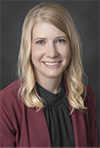While the time between calving and pasture turnout is undoubtedly super busy, it’s important during this time to pay attention to first-calf heifer pairs so they remain healthy and are ready to breed back come spring.
Hopefully, first-calf heifers are the first females to start calving on the ranch. Breeding programs set up this way have advantages over calving all cows at once. First off, once calving season officially starts you are committed to checking cows every three to five hours.
Later in the season, we get somewhat lazy, checking less often and time starts to get split between cows and spring planting preparations.
As heifers require more attention than mature cows (calving difficulty, problems pairing up, nursing, etc.), making them a priority at the beginning of the season will hopefully result in an overall more successful calving season.
Calving first-calf heifers before mature cows also allows them more time to recover from pregnancy and calving and resume fertile estrous cycles before breeding season. Traditionally, we need to rebreed cows within 80 days postpartum in order to maintain a 365-day calving interval.
Breeding heifers to calve before mature cows then allows them closer to 100 days to resume estrous cycles and sets them up with better chances of rebreeding with their second calf early in the breeding season.
Keep records
Keeping track of records before, during and after calving is important to compare a first-calf heifer’s performance throughout the year. Using these records throughout the year can be helpful in making sure she is going down the right path to successfully join the cow herd. Make sure to evaluate pre- and post-calving health, calving performance and nutrition.
Health
- Reduce contaminants – At the beginning of calving season, the barn or pasture is clean, which reduces exposure and the opportunity for pathogens to suppress the immune system. Clean pens frequently or utilize the Sandhills Calving System to maintain a clean environment and keep first-calf heifer pairs healthy.
- Post-calving – Monitor first-calf heifers for proper cleaning and passing of the placenta within 12 hours post-calving. Retained placentas, uterine prolapses, uterine infections or lacerations may occur and cause her discomfort and sickness. These problems may also lead to breeding problems down the road.
Calving performance
- Calving difficulty – How did she perform through her first calving? Did she have any difficulty? It is estimated that 10 to 15 percent of first-calf heifers experience calving difficulties which can negatively affect the postpartum interval and next season pregnancy rates due to additional stress and uterine damage.
If first-calf heifers do experience dystocia, a calving ease score from 1 to 5 (American Hereford Association) can be documented in the calving book. If she has trouble breeding back, progestin-based reproductive technology or controlled internal drug release (CIDR) may need to be utilized to boost her estrous cycle.
Nutrition
- Body condition score (BCS) – First-calf heifers should be at a BCS of 6 by calving. Since heifers are only 85 percent of mature weight at calving, this will provide her adequate nutrients for her continued growth, while also allowing her to meet needs of lactation and resumption of estrous cycles prior to breeding.
o Too fat – Heifers with BCS greater than 6 may have impaired milk production and increased incidence of dystocia, due to extra fat deposition in the udder and around the pelvis, respectively.
These heifers can stand to lose some weight after calving, but it’s important to have her back on a positive plane of nutrition prior to breeding season in order achieve early breed-back.
o Too thin – If heifers are too thin, extra energy will need to be supplemented in order for her to meet nutrient demands for lactation, growth and maintenance. Thin heifers will likely have a longer postpartum interval and may lead to devastating profit losses if they get culled due to late, or failure to, breed back within the desired calving interval.
Condition should be added to thin heifers prior to calving by supplementing with high-quality feedstuffs and feeding separate from mature cows. Body condition can be added postpartum but it will be more difficult and very expensive to her high nutrient demands for lactation.
Frequent observation of first-calf heifers and good recordkeeping around calving will give producers insight into which heifers are going to breed back and others that might need some extra TLC.
Remember that these heifers are the newest assets of the ranch, and it’s important to keep them healthy through their first calving in order to give them the best chance of breeding back and entering into the mature cow herd. ![]()
PHOTO: Keeping records before, during and after calving is important to compare first-calf heifers’ performance throughout the year. Photo by Taylor Grussing.

-
Taylor Grussing
- Cow-Calf Field Specialist
- SDSU Extension
- Email Taylor Grussing







